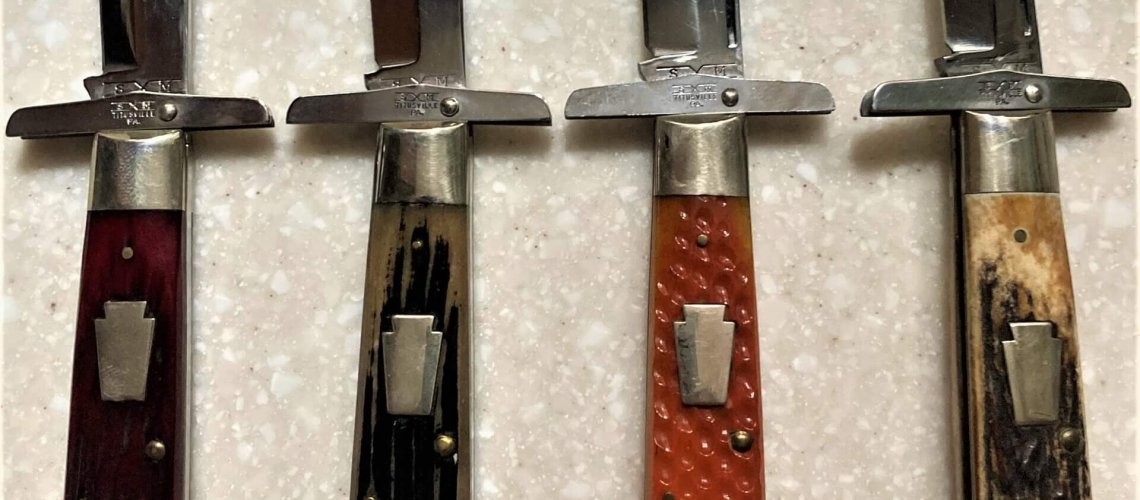
Dan Lago, 8-26-2023.
Introduction
After a short time of searching the Internet, it became clear to me that many more than the few catalog swing guard knives by Queen and Schatt & Morgan were made. With the Internet it is easy to get a list of catalog knives while they are being sold, but private label and non-cataloged knives have never been kept in any public record and there are no permanent records of what has been made. In this sense, the question becomes: “How do catalog knives fit in with the larger set of Queen’s swing guard production over the period from 1992 to 2017?
This article will summarize the catalog knives that Queen produced and “special projects” of Queen that were never cataloged but might be found by diligent collectors. A third article with focus on the Special Factory Orders (SFO) that Queen made for clients. The fourth article, an Excel database, will provide a summary of all the knives mentioned in the earlier three articles – it can be modified to reflect what knives are in your collection.
Our method is simple: a.) buy every such swing guard I can off Internet or shows I attend; or b.) at least get a photo or a description of the many I don’t win; c.) Converse or use social media to learn more about swing guard knives at every chance I get. In particular, Fred Fisher and David Clark, have been extremely helpful. Continue this method for many years and finally, write it all down. Over time, I have adopted a broad three-part classification of Queen swing guards:
Queen Catalog knives, (QC). Simply, knives listed in annual catalogs or company sales literature;
Queen Special Projects, (QSP). Pilot projects, small runs never offered in catalogs, but with clearly identified Queen production on the knife;
Customer Special Factory Orders (SFO). Knife still shows Queen, Schatt & Morgan, or Robeson tang stamps, but also usually shows the name of a sponsoring organization in blade etch or tang stamp, who bought the entire run of knives.
Because new entries can be expected in all categories, I will also use a numbering scheme for each sub-category. An Excel spreadsheet will be used to provide an overview of each knife, and of the groups. The spreadsheet elements include: Item number, model number, years offered, steel, Blade style, blade etch, tang stamp, guard stamp, Bolsters, handle material, shield, box, edition size, serial numbers, and sponsor. The database is available as the fourth element of this set of articles.
Because the physical features of all Queen Swing guard knives are essentially the same, we will summarize them only once: Single lock back blade of 3.5” (this to the top of the bolster. Some reports use a length of 3.3/8” to the top of the swing guard), 4.5” closed length. Most modern knives have both top and bottom bolsters, but a few knives are barehead (top bolster only). Weight is usually between 3.2 oz. and 3.6 oz. depending on handle material. The steel, blade type, blade etches, and many different handle materials, provide the sources of variability. You will see many photos throughout this set of articles.
Queen Catalog Swing Guard knives.
Including the Schatt & Morgan Swing guards, there are only 17 knives in this section, but they have been seen by collectors as extremely nice – especially the Schatt & Morgan Keystone series which launched the re-introduction of this pattern very well.
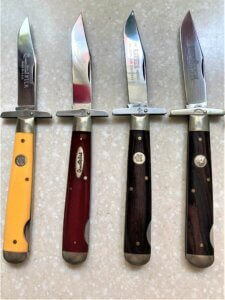
Figure 1. Queen labeled swing guards. From left to right. First, Amber Delrin, the first commercial swing guard in 1992; second, the acrylic crown red swing guard, with the only oval shield Queen used; third, the Rawhide swing guard with brown stabilized wood and blade etch; and fourth, a cocobolo hardwood with D2 tool steel from 2002-2005.

Figure 2. Queen labeled catalog Swing guards. First, carved stag bone (CSB); second, Birds Eye Maple (BEM); third, Amber carved stag bone ACSB); fourth, African Zebra wood; fifth, Olive drab Linen micarta (ODLM). All with D2 Tool Steel.

Figure 3. Schatt & Morgan “Keystone” Series Swing Guards. Offered from 1992-1995, these knives were extremely popular in reviews and purchases. The pattern had been of production since at least 1931 are largely responsible for the fan base of Queen swing guard knives. From left to right, first, the red stag bone, second, the Winterbottom bone; third, an orange corncob bone; and fourth the torched Sambar stag in 1995. This series brought back the spear blade to the pattern in 1994, and it became a widely used blade style after that. Steel used for these knives, while not publicized, is considered to be 420 stainless because it would take a better final polish.
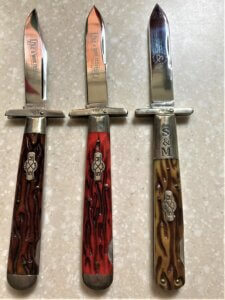
Figure 4. Queen “File and Wire” Swing guards from 1998 to 2007, all using ATS specialty steel and different colors of “worm-grooved” bone (brown, red, and green bone). The green bone on the right uses the only flat guard that Queen ever used and is a “barehead” design – a very unusual catalog knife by Queen. It should be mentioned that the knives in Figures 3 and 4, were produced in much smaller editions than the knives in Figures 1 and 2. Knives in Figures 3 and 4, were produced for only one year and limited editions, around 600 each. The catalogs knives were made for longer periods and their production numbers have not been made public. Because of customer demand and a sightly longer run, the ACSB (middle knife in figure 2) might be a bit more prevalent for collectors.
There is one knife cataloged as 1L “lockback” by Daniels Family Cutlery in 2017 in “Feathered Buffalo Horn” that was apparently also produced as an actual swing guard, (making #17 of this set) but I have not been able to find that knife.
Queen “Special Projects” Swing Guard knives.
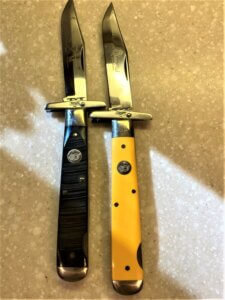
Figure 5. Queen Prototypes ahead of all modern swing guards, in early 1992.
By “special Projects” we mean “never cataloged and made in smaller numbers.” The black sawcut Delrin was the first prototype and was produced in only six units, according to its’ box label. To our knowledge this is the only black sawcut Delrin Queen used and it is not what one thinks of when you think of covers for Schatt & Morgan knives. The same could be said for the Amber Delrin used for the second prototype; the cover shows the same (darned) backspring center crack that so many of this handle material develop over time – the box says this was an edition of 23. Perhaps learning on this protype helped reduce cracking on the Amber 1LA shown in Figure 1, above. You can also see that the prototype shows Queen steel on the blade etch, inconsistent with the Schatt & Morgan tang stamp- internal experimentation.

Figure 6. Left to right, first, ABCA rosewood; second rare script etch and curved tang Queen tang stamp, dark Winterbottom; and third, a prototype for inclusion in 7th Keystone green series, 1 of 1.
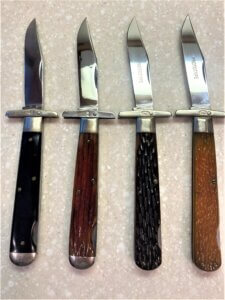
Figure 7. Left to right, first, smooth black Delrin, “factory knife” with no marks; second, rare chestnut Winterbottom; third and fourth, Daniels Family Cutlery era barehead “prototypes” 1 of 3 each.
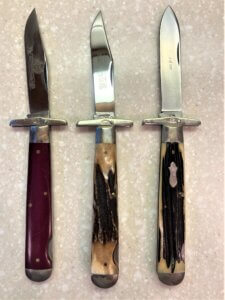
Figure 8. Queen Special Projects, left to right, first, 2002, 80th anniversary etch with smooth Black Cherry Delrin; second, Queen Deer stag with curved tang stamp and clip blade with D2 steel; third Winterbottom bone with spear blade and bomb shield. Second and third by Daniels Family Cutlery, about 2013.
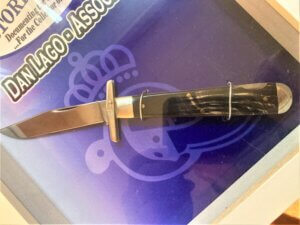
Figure 9. A Queen-labeled swing guard in Feathered Buffalo horn with 420 stainless steel clip blade given to me by Daniels Family Cutlery in 2015 for help with their “Historical Documents” website. It remains in the box. I am told it is 1 of 1 and is certainly not for sale.
Last swing guard knives by Daniels Family Cutlery.
In their five years at the helm of the Queen Cutlery, the Daniels Family was very invested in the swing guard pattern; (see also their efforts in the SFO article that follows this piece). Under their own name they did two series as shown in the next two figures 10 and 11.
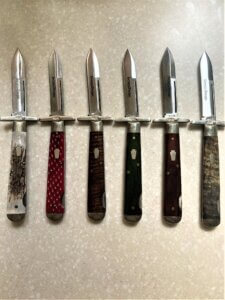
Figure 10. Six Schatt & Morgan swing guards of the set of 8, made in 2016 that used a smaller Keystone shield (check Figure 3 or 6 for comparison). These knives were striking in using an old-style spear blade with long pull and heavy swedge on the front edge that recalled the early successes of the Schatt & Morgan Keystones in the early 1990s. From left to right, first, elk stag; second, red jigged bone; third, brown curly maple; fourth, green smooth wood; fifth, Rosewood; sixth, golden curly maple. No examples of the amber picked bone and stag versions. This was a very nicely finished set, all in very small editions, (30 or less).
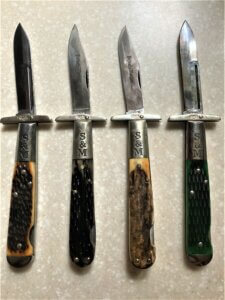
Figure 11. Sample of Schatt & Morgan swing guards with large signature bolsters from a set of nine versions. From left to right, first, Whisky Catalina bone; second, brown reverse worm grooved bone; third, torched Sambar stag, and fourth, green jigged bone. Several knives in this set did not lock up smoothly and were difficult to close – not what I had come to expect. Because of small edition sizes, generally of 30, I was not able to acquire many knives in this final Queen set.
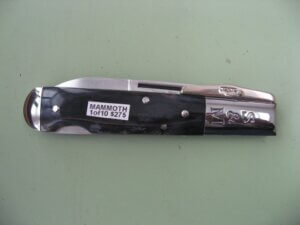
Figure 12. A dark mammoth swing guard in the final set, in an edition of 10. (Internet Photo). This knife also shows a light colored signature bolster, while you usually expect to see a dark initials – probably one more step left out of completing a knife. Others not in my collection of signature bolsters swing guards included Rosewood, Walnut, Blue Shockwood, Mother of pearl, and brown popcorn bone. This series used both clip and spear blades (similar to the 2016 small keystone set), but the clip blades did not have high polish as we have come to expect. Some were barehead, while others used lower bolsters. It is sad to say this final set showed some issues over quality control that troubled the company as financial concerns grew.
Queen Special Projects in Swing Guards in Brands they controlled
Queen controlled Robeson brand though Servotronics and made five swing guards, four as “Shurdege,” and one as “pocketeze.” These knives were limited to editions of 200, or 100 for the Pocketeze – they are not easy to come by, and there may well be others that are still hidden in collections. They all show care in construction and finishing and have always been handled well by Queen (Figures 10 and 11).
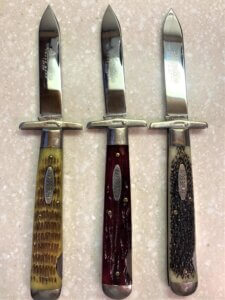
Figure 13. Robeson by Queen “Shuredge” swing guard knives. Left to right. First green jigged bone; second, red stag bone; third, “snakeskin” jigged bone. All three with 420 stainless steel and spear blades, each in an edition of 200.
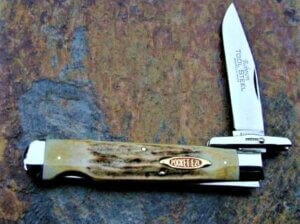

Figure 14. Two more Robesons by Queen, Pocketeze stag (on top) and Shuredge spear point brown worm grooved bone (bottom). (Internet photos). These do seem very consistent with other Queen made Robesons to me.
Queen made only one swing guard for Tuna Valley in 2012, one of the first Tuna Valley knives Daniels Family made when they brought the brand to Queen. It was in stag and used the same flat guard seen in the 2007 file and wire swing guard in an edition of 50. We include an Internet photo of the knife in Figure 15.
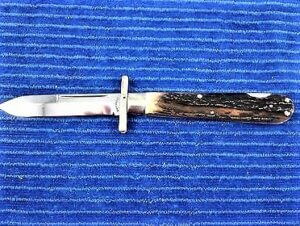
Figure 15. A Queen-made Tuna Valley swing guard made in 2012 in an edition of 50 knives. You can see that this knife provided the blade shape that was used so successfully in the 2016 swing guard series (See Figure 10). (public Internet photo).
Other examples of Queen Swing Guards from the Internet
The following images are from public Internet sites and I have not had a chance to examine them closely, although I do think they are appropriate for your consideration. They are offered as samples of swing guards for Queen collectors to search and make decisions about whether to add them to your collection. They are also included in the Excel database to expand our coverage, pending your detailed observation. The sad truth is that blades for swing guards were sold at Queen’s bankruptcy auction and some knives might be made from parts and not actual cutlery made in the factory to take advantage of the cutlery and pattern’s popularity.
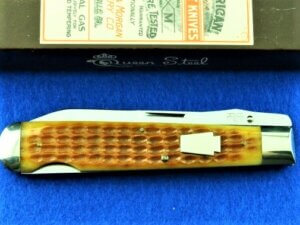
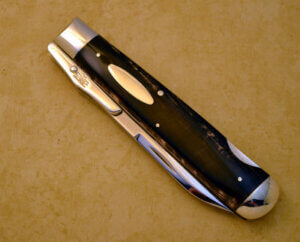
Figure 16. Schatt & Morgan Keystone swing guards, in a honey-colored corncob jigged bone. Queen did use this bone and several other colors have been used. The slightly larger keystone shield also looks like an earlier size used on this pattern. The lower knife is a Shatt & Morgan swing guard spear blade knife in smooth Feathered Buffalo horn, from seller “OneSandyJim” a highly regarded Internet knife seller, showing the unusual early oval shield. Listing included 1993 date and edition of 38. This knife might have been preparation for a knife ordered by Sooner State Knives in the same year, with an “SSK” in the oval (see one in the third article {SFO knives} of this set). Both knives I did not win…! (Internet photos)
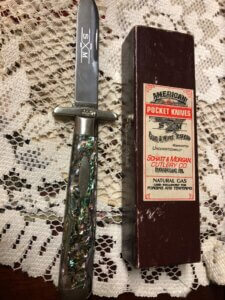
Figure 17. An Abalone Schatt & Morgan swing guard, with the same oval shield, probably also dating to the early 1990s. These was a lot of discussion on this knife online. It was deemed to be “right” and sold for a high price. (Internet photo).

Figure 18. A Mother of Pearl Schatt & Morgan, also with a spear blade. Such large pearl handle materials have not been seen by Queen since the 1990s up to just after the 21st century. As shown, in the third article on SFO knives, there have been several well documented versions of this knife so, it is very likely Queen also made some in its own brand. This knife appears to have a relatively large end cap bolster compared to those SFOs {See Wolverine and Fort City knives in the third article}, perhaps to cope with somewhat shorter pieces of pearl. (Internet photo).
Conclusion and Summary
If you have read this far, you are already a fan of these big folding knives. They contributed greatly to Queen’s success with the reintroduction of the Schatt & Morgan brand and their reputation as a quality maker. This article probably adds to your opportunities to add to your Queen swing guard collection, though not at the price they originally commanded.
In terms of our original question please consult Table 1, below. “How do catalog knives fit in with the larger set of Queen’s swing guard production over the period from 1992 to 2017?
Table 1. Distribution of Queen Swing Guard Knives
Catalog knives total 17 14%
Queen special projects total 40 33%
Special Factory Orders total 66 53%
Total swing guard versions 123 100%
See Excel file as fourth piece in this series on Queencutleryguide.com. for details.
While the popularity of this pattern may undercut the importance of catalog knives, it does suggest that “collector” perspectives were prominently on Queen’s management for nearly the last 30 years. No other pattern of Queen knives has produced the volume of non-cataloged knives as the swing guard. Large trappers (#19) and teardrop versions (#06) appear to have produced less than 25 special knives each, in our accounts (19-premium-Trapper-SFO-3-28-2020.pdf (secureserver.net), 06-and-06L-Teardrop-Knife-versions-3-31-2020.pdf (secureserver.net)), while the swing guard appears to have at least over 100. There may be others – I am still confident that this is a conservative estimate – one set of eyes, only sixteen years, while estimates of maybe 20-25 years for knives hidden in collection to “resurface”. Each one will only strengthen our conclusions.
We will return to the larger issue of Special factory orders (SFO) in the third article to complete our count of the customer-initiated orders for swing guard knives made by Queen.
NOTE: There are probably more swing guard knives out there or already in your collection. If you have suggestion for changes or new content to add, do not hesitate to contact us. Thank you.

